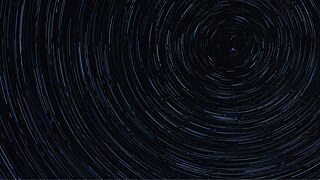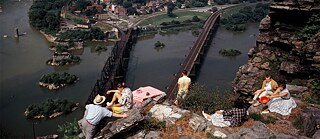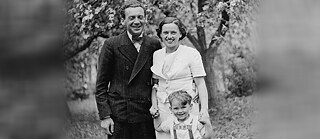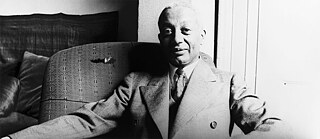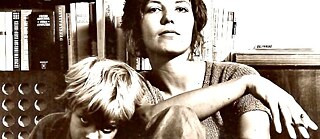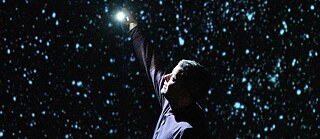Die magische Welt der Bilder
Seeing in the Dark — Volkmar Wentzel’s Photography
Diese Folge porträtiert den deutsch-amerikanischen Fotografen Volkmar Wentzel – 1915 in Dresden geboren, wanderte er mit seiner Familie 1926 in die USA aus. Als junger Mann ging er nach Washington D.C., wo er für die National Geographic arbeitete und einer der legendären ‚field men‘ wurde, welche die gesamte Welt bereisten und fotografierten.
Diese Folge anhören: Apple Music | Spotify | Download
Diese Folge stammt von Katie Davis. Katie ist Autorin und Radioproduzentin in Washington, D.C., ihre Arbeiten wurden bereits in „This American Life“ und NPRs „All Things Considered“ veröffentlicht. In den bisherigen Episoden, die sie für das Goethe‑Institut produziert hat, setzte sie sich mit zahlreichen deutsch-amerikanischen Themen auseinander. In diesem Podcast unterhält sich Katie Davis mit dem Fotografen Volkmar Wentzel und Jessica Beels, die Wentzels Fotos beschreibt. Als Musik ist in der Folge zu hören: „Long Walk“ und „Addis 11“ von David Shulman. Das Foto zur Folge stammt von Volkmar Wentzel aus der NG Image Collection und zeigt Menschen im Jahr 1962 beim Picknick auf den Hügeln über Harpers Ferry in Maryland. Außer dieser Episode hat Katie Davis die Folgen „The Things We Brought“, „Anatomy of an Apology“ und „Thomas Buergenthal – A Lucky Child“ produziert.
Transkript
Katie Davis: When Volkmar Wentzel’s father got frustrated with his sons, he put them in his darkroom. All chemicals and inky black. The darkroom was terrifying, says Volkmar, until he found the red light switch. Then, he says, it was love. The red bulb was a safelight, a way to understand what was emerging. See the images float up out of the water. See himself travelling around the world with a camera. Moving, moving, always documenting.
[MUSIC: LONG WALK RETURNS DAVID SHULMAN]
Katie Davis: Volkmar Wentzel’s photographs are shadowy, evocative.
Jessica Beels [DESCRIBES PHOTO]: This picture is a really deep dark night image of two people talking on the steps of one of the capitol buildings in Washington D.C. The lights are glowing, and the two people are in conversation standing on the steps. It looks like it’s just been raining, and the light from the lamps and from the reflections illuminates the center of the image in a very compelling way both in terms of composition and in terms of the narrative around the people standing on the steps.
Katie Davis: In l926, Volkmar’s father packed up his family and left Dresden, Germany, for the United States. He found work at a photographic company in Binghamton, New York. Volkmar was 11 years old, and spoke no English ... Years later, he remembered in an oral history interview though that boys have their own language.
Volkmar Wentzel [IN AN ORAL HISTORY AT SMITHSONIAN ARCHIVES OF AMERICAN ART]:
My father had subscribed to a boys’ magazine from Germany. It was called Der gute Kamerad (The Good Comrade). It meant, you know, boyhood friend. And in that magazine was a description of how to build a kayak. And so I built a kayak, and I stole all of the lumber and everything from new houses that were being built around the area, including the canvas. So I built one and then all the boys in the neighborhood wanted to have some, too. And it worked fine on the Susquehanna River. So we built eleven kayaks.
Katie Davis: They paddled their kayaks on the Susquehanna River and found the island where the city stored the annual fireworks. They loaded up and started building a rocket boat. “We were like pirates,” says Volkmar Wentzel.
[MUSIC]
Katie Davis: When Volkmar Wentzel was 19, he decided to hitchhike to Brazil with a friend, 15,000 miles from Binghamton, New York to Rio de Janeiro.
Volkmar Wentzel: Yeah so we sold our bicycles and I sold my book, my kayak and everything. Between us we had $140 dollars. And so we set up and thumbed our way south towards South America [LAUGHING].
Katie Davis: They planned to follow the Pan American Highway, but it had not been built yet. No matter. That’s how Volkmar Wentzel moved through the world — confident, willing to go where there were no roads. They stopped in Washington D.C. hoping to interview President Franklin Delano Roosevelt, or FDR.
Volkmar Wentzel: Well we had written Franklin Delano Roosevelt that we were doing this and enclosed one of our cards [LAUGHS]. And so we thought maybe we will be received there. And we got to the White House and we could walk right on in, there was nothing there. The fences were lower than they are now, the iron fences. We walked right up to the portico of the White House and we looked in, glass doors there, we looked in — absolutely dark inside, no FDR ... nothing [laughing]. And then by this time it was at ten, eleven o’clock and it was very windy and cold, it was in February. And I’ll never forget that big lantern swaying, you know, in the wind up there.
[MUSIC: ADDIS ELEVEN BY DAVID SCHULMAN]
Jessica Beels [DESCRIBES PHOTO]: The central focus is a lamp — dead center in the image and the most focussed part of the image. It’s as though you’re looking out of a house and onto the street that’s been illuminated by this beautiful ornate lamp on a very calm night.
Katie Davis: The trip ended in Washington D.C., Volkmar’s friend took a train home and Volkmar threw his backpack down a sewer. He found a job in a dark room mixing chemicals at a news bureau, Underwood and Underwood. And then a photographer gave him a camera, a Speed Graphic, with bellows. It was old, but the lens was sharp.
Volkmar Wentzel: So I had the camera. But I had no time to take pictures. I mean the hours at Underwood and Underwood were long, you know, often until dark. And I had to be there in the morning at eight o’clock and worked all day until six or seven — there was no time. Then my friend Eric said, “Why don’t you take some pictures of Washington by night?” And he gave me a book called Paris de Nuit and that inspired me to take the light pictures.
Jessica Beels [DESCRIBES PHOTO]: This image looks like it could take place almost anywhere where fishermen would dock to sell their fish after the day. There are men sitting around talking to the fishermen in the boat, tied up along the wharf, and the lights on the side of the boat are illuminating their faces. You can see the man in the boat handing a fairly large fish to one of the men on the dock. But then, as you look more closely, you see that the Washington Monument is in the background, and this must be the D.C. Waterfront.
Katie Davis: Volkmar often stayed out all night. He liked to work in the heavy atmosphere of damp and foggy nights. He said the diffused light reduced scenes to their simplest elements: the marble columns, iron gates, and streetcar tracks. Volkmar took these photographs to National Geographic, and he was hired. He started in 1937 as a darkroom lab tech — the way everyone started there. The darkroom, he said, was modern and the tile walls gleamed.
Volkmar Wentzel: Starting with the Geographic, of course, was a totally new life for me. I enjoyed going there. I couldn’t get there early enough in the morning [laughs] to start work. And soon I found out that the real person behind all of this was Gilbert H. Grosvenor. And he was a remarkable man, and he had the vision to use photographs, he was very much for the use of photographs, and he boosted the photo lab and equipment, everything — he was behind all of that.
Katie Davis: Volkmar’s first assignment as a photographer was in West Virginia, and then Sweden, and then his editor called him in and said: “We want you to do India. Do India!” It was a massive assignment at a time of change in the country, really in the whole world.
[MUSIC OF A PLUCKED INSTRUMENT]
Jessica Beels [DESCRIBES PHOTO]: This image of a colonnade in Madras (today: Chennai), India, is viewed from above. The architectural details in the foreground right at the top of the image are really intricate and draw you in. But the light from the outside pulls your eye toward the back. The whole interior is lit up so that you can see all of the arching architecture in the ceiling in succession back to the farthest reach of the space. There are bicycles and a couple of cars parked inside and people milling about on the left. All of them seem to be dressed in white or very light colors. And even though they’re kind of randomly sitting around, they seem very ordered. The architecture looks really crisp but also ancient. There are little bits that look like they’ve been broken off and other parts that look like they have never been touched. I love the progression of the architecture and also the lined-up bicycles and cars. They all seem to relate to each other even though they are just randomly there.
Katie Davis: Volkmar packed 18 cases of equipment and photographed in India for two years. He bought an old ambulance for $600 and fixed it up so that he could develop film in the old ambulance and sleep in it. He painted the words on the side of the ambulance National Geographic Society — Photo Survey, and he drove it 40,000 miles.
Volkmar Wentzel: On way to Jaipur [LAUGHS] the ambulance broke down, had some motor troubles. So it got to be very late when we got the gates of Jaipur. And in Jaipur the gates were locked just like they were in medieval Europe, the city was locked up at night, big gates ... And so there we were in front of Jaipur, the gates of Jaipur, and didn’t know what to do next. But we did find, we walked along, we did find a little door that we could squeeze through, and we unlocked it and drove in to the palace. And the Maharajah and so on, they stay up late, they eat very late, usually ten, eleven o’clock. And so we were received very well and, yeah, and it was like going into another world.
[MUSIC]
Jessica Beels [DESCRIBES PHOTO]: This is a picture of two train cars full of people. It’s a close-up of the intersection between two cars. You can see people’s legs hanging out of the window, people crouched in the window looking into the car, and people looking out at the camera, just sitting there — maybe waiting for the train to leave. It’s a really plain train car and all the detail in this image is the drapery of the people’s clothing and the bend of their legs and feet. The folds of the clothing are almost like abstract patterns in and of themselves.
Katie Davis: After his years photographing the world, Volkmar Wentzel became the first archivist at the National Geographic Society. And he said later in his life that he did not want to just be known for photography but for efforts also to preserve the National Geographic Archives. For THE BIG POND
this is Katie Davis.

